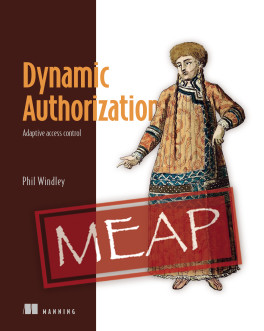pro $24.99 per month
- access to all Manning books, MEAPs, liveVideos, liveProjects, and audiobooks!
- choose one free eBook per month to keep
- exclusive 50% discount on all purchases
- renews monthly, pause or cancel renewal anytime
lite $19.99 per month
- access to all Manning books, including MEAPs!
team
5, 10 or 20 seats+ for your team - learn more

OAuth 2 in Action teaches you the practical use and deployment of this HTTP-based protocol from the perspectives of a client, authorization server, and resource server. You'll learn how to confidently and securely build and deploy OAuth on both the client and server sides.
about the technology
Think of OAuth 2 as the web version of a valet key. It is an HTTP-based security protocol that allows users of a service to enable applications to use that service on their behalf without handing over full control. And OAuth is used everywhere, from Facebook and Google, to startups and cloud services.
about the book
OAuth 2 in Action teaches you practical use and deployment of OAuth 2 from the perspectives of a client, an authorization server, and a resource server. You'll begin with an overview of OAuth and its components and interactions. Next, you'll get hands-on and build an OAuth client, an authorization server, and a protected resource. Then you'll dig into tokens, dynamic client registration, and more advanced topics. By the end, you'll be able to confidently and securely build and deploy OAuth on both the client and server sides.
what's inside
- Covers OAuth 2 protocol and design
- Authorization with OAuth 2
- OpenID Connect and User-Managed Access
- Implementation risks
- JOSE, introspection, revocation, and registration
- Protecting and accessing REST APIs
Provides pragmatic guidance on what to do ... and what not to do.
Unmatched in both scope and depth. Code examples show how protocols work internally.
A thorough treatment of OAuth 2 ... the authors really know this domain.
A complex topic made easy.
team
- five seats for your team
- access to all Manning books, MEAPs, liveVideos, liveProjects, and audiobooks!
- choose another free product every time you renew
- choose twelve free products per year
- exclusive 50% discount on all purchases
- renews monthly, pause or cancel renewal anytime
- renews annually, pause or cancel renewal anytime
-
![]() OAuth 2 in Action ebook for free
OAuth 2 in Action ebook for free
team
- five seats for your team
- access to all Manning books, MEAPs, liveVideos, liveProjects, and audiobooks!
- choose another free product every time you renew
- choose twelve free products per year
- exclusive 50% discount on all purchases
- renews monthly, pause or cancel renewal anytime
- renews annually, pause or cancel renewal anytime
-
![]() OAuth 2 in Action ebook for free
OAuth 2 in Action ebook for free















 OAuth 2 in Action ebook for free
OAuth 2 in Action ebook for free